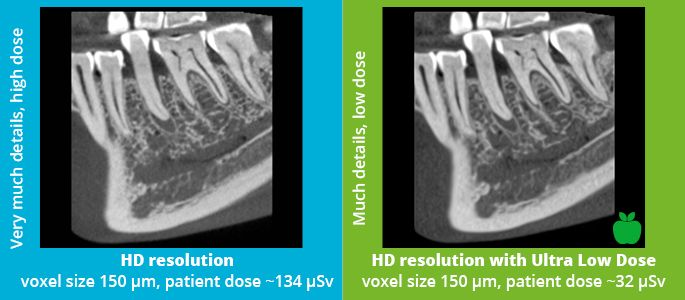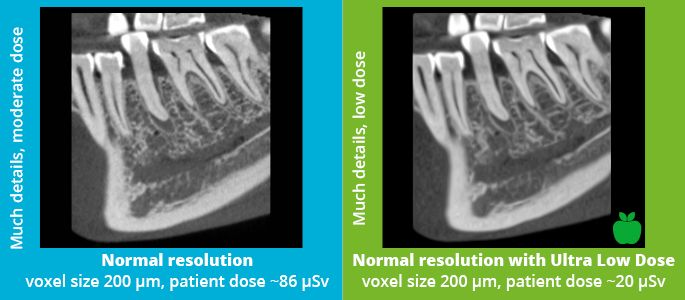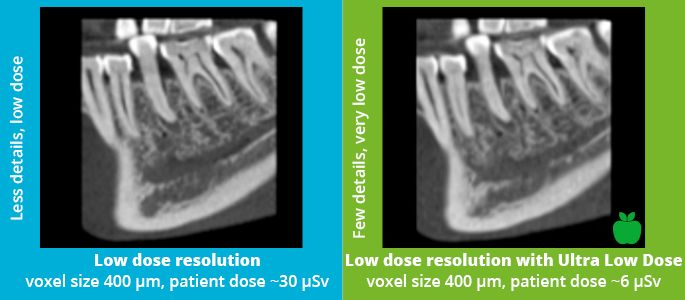Blog post -
Planmeca Ultra Low Dose FAQ – CBCT imaging with lower effective patient dose
As dental imaging continues to evolve, questions regarding reduced doses and patient safety are taking an increasing role. Planmeca ProMax® 3D imaging units offer a unique Planmeca Ultra Low Dose™(ULD) imaging protocol that enables CBCT imaging with an even lower patient radiation dose than standard 2D panoramic imaging. Using the protocol reduces the effective patient dose by an average of 77%. Here are some of the most frequently asked questions about Planmeca ULD.
Q: How does the Planmeca Ultra Low Dose mode work?
A: CBCT X-ray is acquired by taking several 2D frames of the patient by rotating the X-ray source and sensor around the anatomy of the patient. Each frame uses a short X-ray pulse with given kV and mA values.
When applied, the Planmeca ULD protocol will alter the exposure values by lowering the milliamperes and shortening the X-ray pulse needed for each frame. This will not only lower the patient dose but will also result in a faster rotation time making the scan less prone to patient movement artefacts.
Unlike competing low dose CBCT alternatives, the Planmeca ULD protocol does not take fewer frames or use a smaller rotation angle to lower the patient dose. This is why we are able to use the ULD protocol on any resolution or volume size.
Q: When is it recommended to use the ULD mode?
A: The ULD mode has proven to be an excellent way to lower patient doses while still maintaining high diagnostic value. Radiatioin protection guidelines vary in different parts of the world, but there is a global consensus, that a patient should not be exposed to unnecessary patient doses. According to the well-known ALARA (As Low As Reasonably Achievable) principle, imaging doses must be kept as low as reasonably achievable – patients must not be exposed to a higher dosage than needed to acquire images of sufficient diagnostic quality.
While it is always the clinician who decides the volume size and exposure values used, we can say that in general it would be a good option to use the Planmeca ULD mode in the following cases:
- Orthodontics
- Postoperative and follow-up studies
- Localisation of unerupted teeth
- Ear, nose and throat (ENT) studies
- Implant planning
Q: Is there scientific evidence on the effectiveness of the ULD protocol?
A: A scientific study on Planmeca Ultra Low Dose by Ludlow and Koivisto establishes that the low dose imaging protocol enables CBCT imaging with a significantly lower dose than standard imaging, without a statistical reduction in image quality. The study’s conclusion states as follows:
“An average reduction in dose of 77% was achieved using ULD protocols when compared with standard protocols. While this dose reduction was significant, no statistical reduction in image quality between ULD and standard protocols was seen. This would suggest that patient doses can be reduced without loss of diagnostic quality.”
Ludlow, John Barrett and Koivisto, Juha: Dosimetry of Orthodontic Diagnostic FOVs Using Low Dose CBCT protocol) Download a poster for the study.
Q: How do I optimise patient doses for different imaging needs?
A: High resolutions and doses are not always necessary – often less is sufficient. It is enough to see the mandibular nerve channel for implant planning and wisdom tooth extractions, for example. This can be done at an incredibly low dose. See our examples:



Questions answered by Planmeca X-Ray Product Managers Antti Airisto and Erkki Hiltunen.
Related links
Topics
- Business enterprise
Categories
- imaging
- ultra low dose
- faq